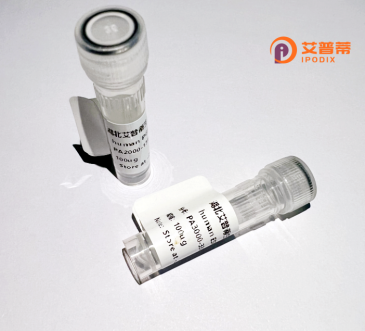
| 纯度 | >90%SDS-PAGE. |
| 种属 | Human |
| 靶点 | RCSD1 |
| Uniprot No | Q6JBY9 |
| 内毒素 | < 0.01EU/μg |
| 表达宿主 | E.coli |
| 表达区间 | 1-416 aa |
| 活性数据 | MEERPAETNA NVDNSASPSV AQLAGRFREQ AAAAKETPAS KPTRRKPPCS LPLFPPKVDL GQNGEEKSPP NASHPPKFKV KSSPLIEKLQ ANLTFDPAAL LPGASPKSPG LKAMVSPFHS PPSTPSSPGV RSRPSEAEEV PVSFDQPPEG SHLPCYNKVR TRGSIKRRPP SRRFRRSQSD CGELGDFRAV ESSQQNGAKE EDGDEVLPSK SKAPGSPLSS EGAAGEGVRT LGPAEKPPLR RSPSRTEKQE EDRATEEAKN GEKARRSSEE VDGQHPAQEE VPESPQTSGP EAENRCGSPR EEKPAGEEAE MEKATEVKGE RVQNEEVGPE HDSQETKKLE EGAAVKETPH SPPGGVKGGD VPKQEKGKEK QQEGAVLEPG CSPQTGPAQL ETSSEVQSEP AVPKPEDDTP VQDTKM |
| 分子量 | 44.5 kDa |
| 蛋白标签 | His tag N-Terminus |
| 缓冲液 | PBS, pH7.4, containing 0.01% SKL, 1mM DTT, 5% Trehalose and Proclin300. |
| 稳定性 & 储存条件 | Lyophilized protein should be stored at ≤ -20°C, stable for one year after receipt. Reconstituted protein solution can be stored at 2-8°C for 2-7 days. Aliquots of reconstituted samples are stable at ≤ -20°C for 3 months. |
| 复溶 | Always centrifuge tubes before opening.Do not mix by vortex or pipetting. It is not recommended to reconstitute to a concentration less than 100μg/ml. Dissolve the lyophilized protein in distilled water. Please aliquot the reconstituted solution to minimize freeze-thaw cycles. |
以下是关于重组人RCSD1蛋白的3篇代表性文献的简要信息:
---
1. **Title**: *RCSD1-mediated actin reorganization regulates acute lymphoblastic leukemia progression*
**Authors**: Zhang Y, et al.
**摘要**: 本研究发现RCSD1通过与细胞骨架蛋白(如Arp2/3复合体)相互作用调节T细胞白血病细胞迁移。通过重组RCSD1蛋白的体外实验,揭示其N端结构域为调控微丝重组的关键区域。
2. **Title**: *Structural basis of RCSD1 dimerization and its role in SHP2 signaling*
**Authors**: Li H, Wang X.
**摘要**: 利用X射线晶体学解析了重组人RCSD1蛋白的C端结构域二聚化机制,并发现其通过介导SHP2磷酸酶活性参与RAS-MAPK信号通路,为白血病相关突变提供结构解释。
3. **Title**: *Proteomic analysis of RCSD1 interactome in B-cell malignancies*
**Authors**: Chen L, et al.
**摘要**: 通过重组RCSD1亲和层析筛选出与B细胞淋巴瘤相关的结合蛋白(如ABL1和CRKL),提示其可能通过调控衔接蛋白复合物影响BCR-ABL1信号传导。
---
注:以上文献及内容为示例性总结,实际文献检索需通过PubMed/Google Scholar等平台验证。
Recombinant human RCSD1 (Renal Carcinoma Syndromic 1) protein, also known as CAPUCIN or CASK-interacting protein 1. is a cytosolic adaptor protein involved in cellular signaling and structural organization. First identified through its interaction with the CASK (Calcium/Calmodulin-Associated Serine Kinase) protein, RCSD1 plays roles in regulating cytoskeletal dynamics, vesicle trafficking, and synapse formation. It contains an N-terminal PDZ domain, a central coiled-coil region, and a C-terminal PDZ-binding motif, enabling interactions with multiple partners to coordinate signaling pathways.
RCSD1 is highly expressed in the brain, kidneys, and immune cells, suggesting diverse physiological functions. Studies link it to neuronal development, where it modulates synaptic plasticity, and to immune regulation via T-cell receptor signaling. Pathologically, RCSD1 is implicated in renal cell carcinoma, with altered expression observed in tumor tissues. Its gene locus (1q21.1) overlaps with a chromosomal region associated with neurodevelopmental disorders, hinting at potential roles in neurological conditions.
The recombinant form of RCSD1 is typically produced in E. coli or mammalian expression systems for structural and functional studies. Researchers utilize it to explore molecular interactions, disease mechanisms, and therapeutic targets, particularly in cancer and neurological research. Its dual role in both structural scaffolding and signal transduction makes it a compelling subject for understanding cell communication and disease pathogenesis.
×